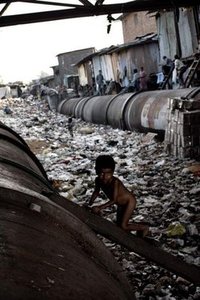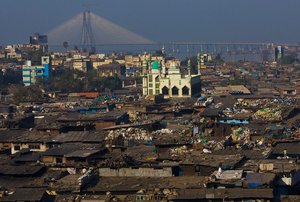Sanjeev Sanyal is not your typical banker. The global strategist at Deutsche Bank has a passion for cities and not just highrise living or hitting the town after work for dinner and a show. As the founder of the Sustainable Planet Institute, Sanjeev has given a lot of thought to how cities grow and what policies are needed to limit their carbon footprint and encourage sustainability.
With more than half the world's population already living in urban environments – and places like India undergoing rapid urbanisation – sound urban environmental policies are needed now more than ever. Gaia Discovery contributor Michael Switow caught up with Sanjeev, an invited speaker at the Qi Global Conference in Singapore, to talk about urban development, improving livelihoods and making the urban jungle a bit more environmentally friendly.
Singapore, 31 October 2011.
You're an environmentalist, but you focus on cities. Why?
Environmentalists traditionally put a great deal of effort into trying to protect forests or rivers and so on, which is obviously fantastic. But you have to recognise that much of the strain that is being placed on rivers, seas, forests and other natural resources is a result of things that happen in the city. More than 50% of the world's population lives in cities. More than 80% of the world's economic activity happens there. So if we do not think about how cities function, then necessarily, we will end up making a mess of everything else.
What's better for the environment: a big city or small town?
Very often, a city that does not look 'green' is actually greener than you think. A city which is very dense like Manhattan may look like an environmental disaster, but in fact it is actually better for the environment in many ways than a flat suburbia, because it manages to restrict a huge amount of economic activity in a small area.

Sanjeev Sanyal: Plan urban developments around walking pathsI'll give you an example: Atlanta and Barcelona are roughly the same size. They both have 2.8 million people and they have roughly the same standard of living. Yet Barcelona's per capita ecological footprint is one-fourth that of Atlanta. Why? Because Barcelona is dense and Atlanta is spread-out. Atlanta uses a huge amount of land; public transportation doesn't work because of the low density, so the city is built around cars. A huge amount of wastage happens as well because of the amount of land that has to be lit up. In Barcelona, on the other hand, urban services can be delivered in a much more concentrated way.
So while denser cities may not look beautiful from an ecological perspective, they actually lower the per capita use of the earth's resources and are in fact actually greener than flat so-called green suburbia.
You've advised governments across the globe as well as the United Nations Environment Programme. What is your main piece of advice on climate change?
Invest in walking. This is the single most important design paradigm needed to lower a city's climate impact.
Walking?
If you use walkability as the key design parameter on which you build cities, it would completely change the way you design cities. Walking is not just a good way of getting from point A to point B for short distances; no public transport system can function without the first mile or last mile being walked. It is the cheapest way of doing it; it's also healthy and forces cities to be designed more densely. People should be able to walk to work as well as to urban amenities like schools, parks, restaurants and shops.
We're not just talking about building more footpaths. There needs to be a combination of over/underpasses, safe crossings and public spaces as well as supporting infrastructure like public toilets, signs, security systems and access for the physically challenged.

Proper drainage and infrastuctural care are needed in Indian slumsOddly enough, many old cities in India were built on a walking paradigm and they have survived for thousands of years perfectly well. Now unfortunately new cities in India are being designed along the lines of American suburbia. We are building cities meant for the car, not for walking. And so one of the very important things that I keep emphasising is that you must design walking networks.
Can you share a couple of examples?
Take Delhi. It's an ancient city that has been built and rebuilt many times and it has a complex canal and drainage system that is hundreds of years old. Even today, there is something like 300-350 km of large ditches and canals, some of which run right through the heart of the city. The government is slowly covering them up and turning the canals into roads. But what we should be doing is cleaning up the drains – because they are an important part of the ecosystem which allows water and other things to sink through to the water table – and creating a network of walking paths. Today, Dehli is poorly designed for public transport. But if you suddenly network it with several hundred kilometers of walking paths, we would dramatically open up the city and change the way we think about it.
Or look at Varanasi. Modern Indian policy views the city as a disaster, because there are lots of narrow lanes going everywhere. But it's a disaster only if you look at it from the perspective of a car. For walkers, the city is perfectly fine. What does it matter to someone on foot if the lane goes back and forth, and up and down. Varanasi has survived for thousands of years; its neighbourhoods are vibrant, it's a centre of learning and tourism. Yet it follows none of the rules that urban planners in India and elsewhere believe are good ideas.
As a member of a working committee on urban strategies advising the Indian government, you highlight the importance of property rights in slums. Why?

Property rights set the pace for development even in slumsPeople tend to think of property rights as something for the rich, to protect their rights. But in fact, property rights are just as important, in fact more important for the poor. Even though they have smaller assets, the personal value they attach to those assets is very very high and if one does not provide them clear property rights, it becomes a problem.
The existence or absence of property rights determines the pace at which a place can improve itself. Compare the slums in Bombay and Dehli. In Bombay, slums are basically on squatted land and the property rights are not clear. In Dehli, though, the slums typically tend to be old villages. As a result, villagers – whose property rights are clear – invest in their land and upgrade themselves. In Bombay they don't. Bombay slums only improve through outside intervention. In Delhi, they evolve.
We're sitting in a cafe here in Singapore at Goodman Arts Centre that used to be a school. You've advised urban planners in both India and Singapore. How would you contrast the experience?

Few but integrated steps are taken in Singapore's city planning over timeThe fundamental error that we continue to make in India is that we have this rigid masterplan-based thinking about cities. There is this whole idea that there's a masterplan and if we think through this great idea and plan it in meticulous detail, then we'll get a wonderful perfect city at the end of the process. But all this does is create sterile cities. Cities are not static animals, they are evolving, rapidly changing organisms and we need to think about cities in completely different ways.
On the other hand, look at Singapore. Over the last decade, Singapore has built all kinds of things right in the middle of the city. There's a casino, a theatre complex, a new university and residential housing all right next to the financial district. Rather than try to create neat separated zoned developments, Singapore's planners have recognised the mish-mash nature of organic cities and have deliberately simulated it. Yes, it required a certain kind of planning, but it's very different.
Sanjeev Sanyal authored “The Indian Renaissance: India’s Rise After a Thousand Years of Decline”. He was also named the “Young Global Leader 2010” by the World Economic Forum in Davos.
Gaia Discovery is a media partner of QI Gobal Conference.
Photo sources: Gaia Discovery, Slum Free India and Sustainable Planet Institute
